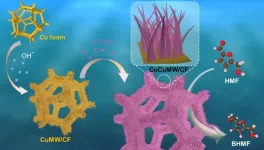(Press-News.org) HOUSTON – (Feb. 10, 2025) – Rice University scientists and collaborators at Baylor College of Medicine (BCM) have demonstrated a new method for detecting the presence of dangerous chemicals from tobacco smoke in human placenta with unprecedented speed and precision.
The research team used a combination of light-based imaging techniques and machine learning (ML) algorithms to identify and label polycyclic aromatic hydrocarbons (PAHs) and their derivatives (PACs) ⎯ toxic compounds generated through the incomplete combustion of organic materials. Exposure to these chemicals during pregnancy can result in negative health outcomes such as preterm birth, low birth weight and developmental problems.
“Our work addresses a critical challenge in maternal and fetal health by improving our ability to detect harmful compounds like PAHs and PACs in placenta samples,” said Oara Neumann, a Rice research scientist who is the first author on a study published in Proceedings of the National Academy of Sciences. “The findings reveal that machine-learning-enhanced vibrational spectroscopy can accurately distinguish between placental samples from smokers and nonsmokers.”
The new method was used to analyze the placentas of women who reported smoking during pregnancy and self-reported nonsmokers, confirming that PAHs and PACs were present only in the samples collected from smokers. The findings offer a critical tool for environmental and health monitoring, enabling the identification and labeling of harmful toxins associated with smoking as well as other sources such as wildfires, conflagrations, Superfund sites and other high-pollution environments and contaminated products.
“Measuring levels of environmental chemicals in the placenta can give us insight into the exposures that both mom and baby experienced during pregnancy,” said Melissa Suter, an assistant professor of obstetrics and gynecology at BCM. “This information can help us understand how these chemicals can affect the pregnancy and the baby’s development and help scientists inform public health measures.”
The research relied on surface-enhanced spectroscopy, a method that uses specially designed nanomaterials to amplify the way that specific light wavelengths interact with targeted compounds. In this case, the researchers leveraged the special optical properties of gold nanoshells designed in the Nanoengineered Photonics and Plasmonics research group led by Naomi Halas , University Professor and the Stanley C. Moore Professor of Electrical and Computer Engineering at Rice.
“We combined two complementary techniques ⎯ surface-enhanced Raman spectroscopy and surface-enhanced infrared absorption ⎯ to generate highly detailed vibrational signatures of the molecules in the placental samples,” said Halas, who is the corresponding author on the study.
Halas together with Peter Nordlander, the Wiess Chair in Physics and Astronomy and professor of electrical and computer engineering and materials science and nanoengineering at Rice, have made significant contributions to plasmonics, the study of light-induced collective oscillations of free electrons on the surface of metallic nanoparticles. Surface-enhanced spectroscopy leverages plasmonics to make possible the in-depth study of molecular structures with very high resolution at the trace concentrations found in biological and environmental samples.
The integration of ML algorithms ⎯ characteristic peak extraction (CaPE) and characteristic peak similarity (CaPSim) ⎯ revealed subtle patterns in the data that would otherwise have gone undetected. CaPE identified key chemical signatures from the complex datasets, while CaPSim matched these signals to known PAH chemical signatures. This outcome showcases the transformative impact of computational tools for medical and public health applications.
Ankit Patel, assistant professor of electrical and computer engineering at Rice and assistant professor of neuroscience at BCM, said that ML served to “tune out the ‘noise’ in the data.”
“It’s like the so-called ‘cocktail-party effect,’” Patel said. “Picture a noisy and crowded room with lots of people talking at once. We are able to focus our attention on a particular conversation only by tuning out the rest ⎯ in the same way, machine learning is able to parse through the spectral data associated with PAHs and PACs much more effectively than humans can.”
Subsequent experiments validated the research findings, confirming that the new method provides a functional alternative to traditional, more labor- and time-intensive techniques. Beyond smoking-related exposure, the research could enable monitoring exposure to environmental toxins after natural disasters or industrial accidents, equipping health care providers with a faster and more reliable way to assess risk and potentially improve fetal and maternal health outcomes.
“This new method offers an unprecedented level of detail,” said Bhagavatula Moorthy, the Kurt Randerath MD Endowed Chair and Professor of Pediatrics and Neonatology at BCM. “This research lays the groundwork for expanding ultrasensitive PAH- and PAC-detection technology in biological fluids such as blood and urine as well as in the environmental monitoring of PAHs, PACs and other hazardous chemicals in air, water and soil, thereby aiding in human risk assessment.”
Other Rice co-authors include computer science doctoral alum Yilong Ju, who developed the ML algorithm, and Andres Sanchez-Alvarado, an electrical and computer engineering Ph.D. student in the Halas research group who was part of the team that conducted the experiments.
The research was supported by the National Institutes of Health (P42ES027725), the Welch Foundation (C-1220, C-1222) and Rice’s Smalley-Curl Institute. The content herein is solely the responsibility of the authors and does not necessarily represent the official views of the funding organizations and institutions.
-30-
This news release can be found online at news.rice.edu.
Follow Rice News and Media Relations via Twitter @RiceUNews.
Peer-reviewed paper:
Machine Learning-enhanced Surface-Enhanced Spectroscopic Detection of Polycyclic Aromatic Hydrocarbons in Human Placenta | Proceedings of the National Academy of Sciences | DOI: 10.1073/pnas.2422537122
Authors: Oara Neumann, Yilong Lu, Andres Sanchez-Alavarado, Guodong Zhou, Weiwu Jiang, Bhagavatula Moorthy, Melissa Suter, Ankit Patel, Peter Nordlander and Naomi Halas
https://doi.org/10.1073/pnas.2422537122
Access associated media files:
https://rice.box.com/s/xo2c07vnwa6ns34b0omf0w5iu7k2em6e
CAPTION: Peter Nordlander (from left), Oara Neumann, Melissa Suter, Bhagavatula Moorthy, Ankit Patel and Naomi Halas (Photo by Jeff Fitlow/Rice University)
About Rice:
Located on a 300-acre forested campus in Houston, Texas, Rice University is consistently ranked among the nation’s top 20 universities by U.S. News & World Report. Rice has highly respected schools of architecture, business, continuing studies, engineering and computing, humanities, music, natural sciences and social sciences and is home to the Baker Institute for Public Policy. Internationally, the university maintains the Rice Global Paris Center, a hub for innovative collaboration, research and inspired teaching located in the heart of Paris. With 4,776 undergraduates and 4,104 graduate students, Rice’s undergraduate student-to-faculty ratio is just under 6-to-1. Its residential college system builds close-knit communities and lifelong friendships, just one reason why Rice is ranked No. 1 for lots of race/class interaction and No. 7 for best-run colleges by the Princeton Review. Rice is also rated as a best value among private universities by the Wall Street Journal and is included on Forbes’ exclusive list of “New Ivies.”
END
Rice-BCM research enables detection of hazardous chemicals in human placenta with unprecedented speed and precision
Light-based detection and machine learning are a powerful health screening duo
2025-02-10
ELSE PRESS RELEASES FROM THIS DATE:
Researchers are driving the charge of zero emissions
2025-02-10
No exhaust means no emissions, right?
Not quite.
It is commonly known that while electric vehicles do not produce tailpipe greenhouse gas emissions while driving, they do create debris from tire and brake abrasion. However, the degree to which they do and how that compares to internal combustion engine vehicles was largely unknown until the Virginia Tech Transportation Institute's Hesham Rakha investigated it.
In an article published in Transportation Research Part D: Transport and Environment, Rakha, alongside institute research associate Mohamed Farag and Associate Professor of civil and environmental engineering Hosein Foroutan, reported findings ...
USC-led study finds potential new drug target for Alzheimer’s disease
2025-02-10
A team of researchers from the Keck School of Medicine of USC has unlocked the details of a cellular pathway that triggers cellular inflammation and aging and is linked to Alzheimer’s disease, particularly among those who carry the APOE4 genetic risk. They have also found a way to return cells to a healthy state, revealing a new potential approach to treatment. The study, the culmination of a decade of research on a protein known as ATP-binding cassette transporter A1 (ABCA1), was just published in the journal Molecular Neurodegeneration.
Past research ...
Why you need to subscribe to NFCR’s new podcast, “All Things Cancer”
2025-02-10
Kick-Off Episode with Dr. Margaret Foti, CEO of AACR, Premieres February 11
Bethesda, MD – February 7, 2025 – The National Foundation for Cancer Research (NFCR) is excited to announce the official launch of its groundbreaking new podcast, All Things Cancer, premiering on February 11, 2025. Hosted by NFCR CEO, Sujuan Ba, Ph.D., this compelling series will bring together the entire ecosystem of cancer research—including leading scientists, oncologists, doctors, patient advocates, caregivers, biotech innovators, and survivors—for powerful discussions on the breakthroughs shaping the future of cancer research, treatment, and ...
Research pinpoints weakness in lung cancer’s defenses
2025-02-10
At a glance:
Researchers discovered the importance of an enzyme that promotes growth of certain lung cancers.
The enzyme, GUK1, supports metabolism in cancer cells to help tumors grow.
In the future, GUK1 could become a possible target for lung cancer therapies.
Lung cancer is a particularly challenging form of cancer. It often strikes unexpectedly and aggressively with little warning, and it can shapeshift in unpredictable ways to evade treatment.
While researchers have gleaned important insights into the ...
New study highlights healthcare utilization shifts among Long COVID patients in Colorado after diagnosis
2025-02-10
AURORA, Colo. (Feb 10, 2025) – A new study analyzing Long COVID healthcare utilization in Colorado reveals a significant shift from acute care to outpatient services following diagnosis, shedding light on evolving treatment patterns and the broader healthcare burden posed by the condition.
The study, published today in BMC Public Health, was conducted using Colorado’s comprehensive All-Payer Claims Database and provides one of the most detailed population-level insights into Long COVID patients to date. Researchers examined utilization patterns of individuals diagnosed with Long COVID between October 2021 and August 2022, tracking them for one-year post-diagnosis.
“The ...
Majority of kids who die in mass shootings killed by family members, Stanford Medicine-led study shows
2025-02-10
When U.S. children die in mass shootings, most of the time the perpetrator is a family member, new Stanford Medicine-led research shows.
The findings, which will be published online Feb. 10 in JAMA Pediatrics, come from the first analysis of the relationships between mass shooting perpetrators and pediatric victims, those who are younger than 18 years old.
“It was surprising that domestic violence was so pervasive, that 59% of kids who died in mass shootings were at the hands of a family member,” said ...
How perception may shape health safety-related assessments
2025-02-10
Perceiving whether another person is a personal health risk requires quickly assessing their trustworthiness. With limited characteristics available, implicit assumptions often influence risk perception. Research in this area has pointed to brain regions that may be involved in perceiving others as untrustworthy or as carriers of sexually transmitted diseases (STDs). However, the relationship between brain activity, perceived trustworthiness of others, and perceived likelihood of acquiring an STD was unclear prior to a recent study published in eNeuro. In the study led by Daniela Mier at ...
Potential new strategy for relieving anxiety
2025-02-10
Understanding the neural circuits that drive anxiety may help researchers discover circuit-specific targets and therefore increase the precision of treatment strategies. Previous studies have separately suggested that increased serotonin levels and the cerebellum may play roles in anxiety. To explore the relationship between these ideas, Pei Chin, from the University of Pennsylvania, and George Augustine, from Temasek Life Sciences Laboratory, probed whether serotonin in the cerebellum causes anxiety behavior in mice. Contrary to previous ...
Scientists develop corrosion-induced electrodes for biomass upgrading
2025-02-10
A research team led by Prof. ZHANG Jian from the Ningbo Institute of Materials Technology and Engineering (NIMTE) of the Chinese Academy of Sciences (CAS) has utilized metal corrosion to prepare high-performance electrodes, enabling efficient and cost-effective upgrading of bio-based 5-hydroxymethylfurfural (HMF). This study was published in Chem Catalysis.
Corrosion is a common phenomenon that can lead to material failure and economic losses. However, researchers are exploring its potential for beneficial applications, particularly in biomass upgrading.
Biomass is among the most abundant renewable resources on earth. Through catalytic conversion, ...
Contemporary hormonal contraception and risk of venous thromboembolism
2025-02-10
About The Study: This study showed venous thromboembolism (VTE) risk variation across hormonal contraceptives with highest rates for combined pills, especially those containing third-generation progestins, and no significant difference in risk for intrauterine devices (IUDs) relative to no use. For patches and implants, the increased VTE risk was uncertain due to limited data. Variation in VTE risk across products underscores the importance of personalized contraceptive counseling.
Corresponding Author: To contact the corresponding author, Harman Gailan Hassan Yonis, MD, email harman@live.dk.
To ...
LAST 30 PRESS RELEASES:
Making lighter work of calculating fluid and heat flow
Normalizing blood sugar can halve heart attack risk
Lowering blood sugar cuts heart attack risk in people with prediabetes
Study links genetic variants to risk of blinding eye disease in premature infants
Non-opioid ‘pain sponge’ therapy halts cartilage degeneration and relieves chronic pain
AI can pick up cultural values by mimicking how kids learn
China’s ecological redlines offer fast track to 30 x 30 global conservation goal
Invisible indoor threats: emerging household contaminants and their growing risks to human health
Adding antibody treatment to chemo boosts outcomes for children with rare cancer
Germline pathogenic variants among women without a history of breast cancer
Tanning beds triple melanoma risk, potentially causing broad DNA damage
Unique bond identified as key to viral infection speed
Indoor tanning makes youthful skin much older on a genetic level
Mouse model sheds new light on the causes and potential solutions to human GI problems linked to muscular dystrophy
The Journal of Nuclear Medicine ahead-of-print tip sheet: December 12, 2025
Smarter tools for peering into the microscopic world
Applications open for funding to conduct research in the Kinsey Institute archives
Global measure underestimates the severity of food insecurity
Child survivors of critical illness are missing out on timely follow up care
Risk-based vs annual breast cancer screening / the WISDOM randomized clinical trial
University of Toronto launches Electric Vehicle Innovation Ontario to accelerate advanced EV technologies and build Canada’s innovation advantage
Early relapse predicts poor outcomes in aggressive blood cancer
American College of Lifestyle Medicine applauds two CMS models aligned with lifestyle medicine practice and reimbursement
Clinical trial finds cannabis use not a barrier to quitting nicotine vaping
Supplemental nutrition assistance program policies and food insecurity
Switching immune cells to “night mode” could limit damage after a heart attack, study suggests
URI-based Global RIghts Project report spotlights continued troubling trends in worldwide inhumane treatment
Neutrophils are less aggressive at night, explaining why nighttime heart attacks cause less damage than daytime events
Menopausal hormone therapy may not pose breast cancer risk for women with BRCA mutations
Mobile health tool may improve quality of life for adolescent and young adult breast cancer survivors
[Press-News.org] Rice-BCM research enables detection of hazardous chemicals in human placenta with unprecedented speed and precisionLight-based detection and machine learning are a powerful health screening duo




